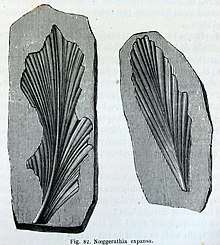
The Carboniferous is a geologic period and system of the Paleozoic that spans 60 million years from the end of the Devonian Period 358.9 Ma to the beginning of the Permian Period, 298.9 Ma. In North America, the Carboniferous is often treated as two separate geological periods, the earlier Mississippian and the later Pennsylvanian.
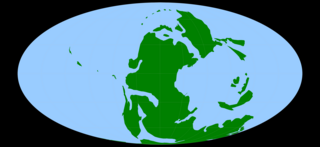
The Permian is a geologic period and stratigraphic system which spans 47 million years from the end of the Carboniferous Period 298.9 million years ago (Mya), to the beginning of the Triassic Period 251.902 Mya. It is the last period of the Paleozoic Era; the following Triassic Period belongs to the Mesozoic Era. The concept of the Permian was introduced in 1841 by geologist Sir Roderick Murchison, who named it after the region of Perm in Russia.

Lycopodiopsida is a class of vascular plants known as lycopods, lycophytes or other terms including the component lyco-. Members of the class are also called clubmosses, firmosses, spikemosses and quillworts. They have dichotomously branching stems bearing simple leaves called microphylls and reproduce by means of spores borne in sporangia on the sides of the stems at the bases of the leaves. Although living species are small, during the Carboniferous, extinct tree-like forms (Lepidodendrales) formed huge forests that dominated the landscape and contributed to coal deposits.

Cycads are seed plants that typically have a stout and woody (ligneous) trunk with a crown of large, hard, stiff, evergreen and (usually) pinnate leaves. The species are dioecious, that is, individual plants of a species are either male or female. Cycads vary in size from having trunks only a few centimeters to several meters tall. They typically grow very slowly and live very long. Because of their superficial resemblance, they are sometimes mistaken for palms or ferns, but they are not closely related to either group.
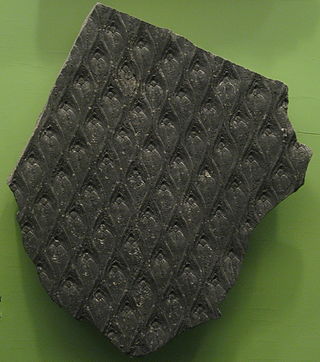
Lepidodendron is an extinct genus of primitive lycopodian vascular plants belonging the order Lepidodendrales. It is well preserved and common in the fossil record. Like other Lepidodendrales, species of Lepidodendron grew as large-tree-like plants in wetland coal forest environments. They sometimes reached heights of 50 metres, and the trunks were often over 1 m (3.3 ft) in diameter. They are often known as "scale trees", due to their bark having been covered in diamond shaped leaf-bases, from which leaves grew during earlier stages of growth. However, they are correctly defined as arborescent lycophytes. They thrived during the Carboniferous Period, and persisted until the end of the Permian around 252 million years ago. Sometimes erroneously called "giant club mosses", the genus was actually more closely related to modern quillworts than to modern club mosses. In the form classification system used in paleobotany, Lepidodendron is both used for the whole plant as well as specifically the stems and leaves.

Equisetidae is one of the four subclasses of Polypodiopsida (ferns), a group of vascular plants with a fossil record going back to the Devonian. They are commonly known as horsetails. They typically grow in wet areas, with whorls of needle-like branches radiating at regular intervals from a single vertical stem.

Pteridospermatophyta, also called "pteridosperms" or "seed ferns" are a polyphyletic grouping of extinct seed-producing plants. The earliest fossil evidence for plants of this type are the lyginopterids of late Devonian age. They flourished particularly during the Carboniferous and Permian periods. Pteridosperms declined during the Mesozoic Era and had mostly disappeared by the end of the Cretaceous Period, though Komlopteris seem to have survived into Eocene times, based on fossil finds in Tasmania.
The Mazon Creek fossil beds are a conservation lagerstätte found near Morris, in Grundy County, Illinois. The fossils are preserved in ironstone concretions, formed approximately 309 million years ago in the mid-Pennsylvanian epoch of the Carboniferous period. These concretions frequently preserve both hard and soft tissues of animal and plant materials, as well as many soft-bodied organisms that do not normally fossilize. The quality, quantity and diversity of fossils in the area, known since the mid-nineteenth century, make the Mazon Creek lagerstätte important to paleontologists attempting to reconstruct the paleoecology of the sites. The locality was declared a National Historic Landmark in 1997.
Gigantopterids (Gigantopteridales) is an extinct, possibly polyphyletic group of seed plants known from the Permian period. Gigantopterids were among the most advanced land plants of the Paleozoic Era and disappeared around the Permian–Triassic extinction event around 252 million years ago. Though some lineages of these plants managed to persist initially, they either disappeared entirely or adapted radically, evolving into undetermined descendants, as surviving life prospered again in much-altered ecosystems. One hypothesis proposes that at least some "gigantopterids" became the ancestors of angiosperms and/or Bennettitales and/or Caytoniales.

The progymnosperms are an extinct group of woody, spore-bearing plants that is presumed to have evolved from the trimerophytes, and eventually gave rise to the gymnosperms, ancestral to acrogymnosperms and angiosperms. They have been treated formally at the rank of division Progymnospermophyta or class Progymnospermopsida. The stratigraphically oldest known examples belong to the Middle Devonian order the Aneurophytales, with forms such as Protopteridium, in which the vegetative organs consisted of relatively loose clusters of axes. Tetraxylopteris is another example of a genus lacking leaves. In more advanced aneurophytaleans such as Aneurophyton these vegetative organs started to look rather more like fronds, and eventually during Late Devonian times the aneurophytaleans are presumed to have given rise to the pteridosperm order, the Lyginopteridales. In Late Devonian times, another group of progymnosperms gave rise to the first really large trees known as Archaeopteris. The latest surviving group of progymnosperms is the Noeggerathiales, which persisted until the end of the Permian.
This article attempts to place key plant innovations in a geological context. It concerns itself only with novel adaptations and events that had a major ecological significance, not those that are of solely anthropological interest. The timeline displays a graphical representation of the adaptations; the text attempts to explain the nature and robustness of the evidence.
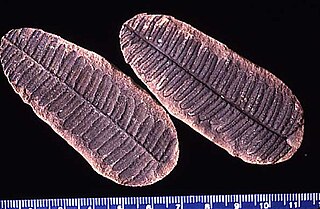
Pecopteris is a very common form genus of leaves. Most Pecopteris leaves and fronds are associated with the marattialean tree fern Psaronius. However, Pecopteris-type foliage also is borne on several filicalean ferns, and at least one seed fern. Pecopteris first appeared in the Devonian period, but flourished in the Carboniferous, especially the Pennsylvanian. Plants bearing these leaves became extinct in the Permian period, due to swamps disappearing and temperatures on Earth dropping.

The Medullosales is an extinct order of pteridospermous seed plants characterised by large ovules with circular cross-section and a vascularised nucellus, complex pollen-organs, stems and rachides with a dissected stele, and frond-like leaves. Their nearest still-living relatives are the cycads.
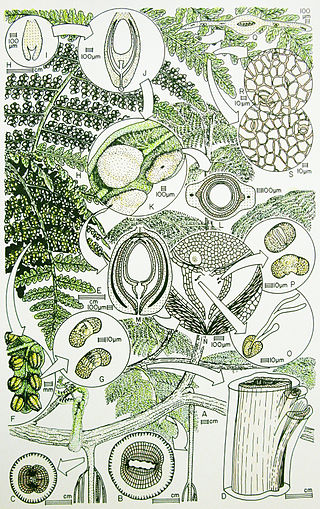
Callistophytales is an extinct order of spermatophytes which lived from the Pennsylvanian to Permian periods. They were mainly scrambling and lianescent (vine-like) plants found in the wetland "coal swamps" of Euramerica and Cathaysia. Like many other early spermatophytes, they could be described as "seed ferns", combining ovule-based reproduction with pinnate leaves superficially similar to modern ferns.

The Callistophytaceae was a family of seed ferns (pteridosperms) from the Carboniferous and Permian periods. They first appeared in late Middle Pennsylvanian (Moscovian) times, 306.5–311.7 million years ago (Ma) in the tropical coal forests of Euramerica, and became an important component of Late Pennsylvanian vegetation of clastic soils and some peat soils. The best known callistophyte was documented from Late Pennsylvanian coal ball petrifactions in North America.

The Carboniferous rainforest collapse (CRC) was a minor extinction event that occurred around 305 million years ago in the Carboniferous period. The event occurred at the end of the Moscovian and continued into the early Kasimovian stages of the Pennsylvanian.

Sphenopteris is a genus of seed ferns containing the foliage of various extinct plants, ranging from the Devonian to Late Cretaceous. One species, S. höninghausi, was transferred to the genus Crossotheca in 1911.

The Archer City Formation is a geological formation in north-central Texas, preserving fossils from the Asselian and early Sakmarian stages of the Permian period. It is the earliest component of the Texas red beds, introducing an tropical ecosystem which will persist in the area through the rest of the Early Permian. The Archer City Formation is preceded by the cool Carboniferous swamp sediments of the Markley Formation, and succeeded by the equally fossiliferous red beds of the Nocona Formation. The Archer City Formation was not named as a unique geological unit until the late 1980s. Older studies generally labelled its outcrops as the Moran or Putnam formations, which are age-equivalent marine units to the southwest.

Macroneuropteris is a genus of Carboniferous seed plants in the order Medullosales. The genus is best known for the species Macroneuropteris scheuchzeri, a medium-size tree that was common throughout the late Carboniferous Euramerica. Three similar species, M. macrophylla, M. britannica and M. subauriculata are also included in the genus.

The Peltaspermales are an extinct order of seed plants, often considered "seed ferns". They span from the Late Carboniferous to the Early Jurassic. It includes at least one valid family, Peltaspermaceae, which spans from the Permian to Early Jurassic, which is typified by a group of plants with Lepidopteris leaves, Antevsia pollen-organs, and Peltaspermum ovulate organs, though the family now also includes other genera like Peltaspermopsis, Meyenopteris and Scytophyllum. Along with these, two informal groups of uncertain taxonomic affinities exist, each centered around a specific genus ; Supaia and Comia, known from the Early Permian of the Northern Hemisphere, especially of North America. Both the "Comioids" and the "Supaioids" are associated with the peltaspermacean ovulate organ Autunia. The Late Triassic-Middle Jurassic genus Pachydermophyllum may also have affinities to the peltasperms.
